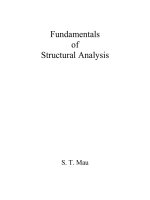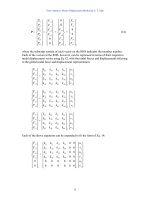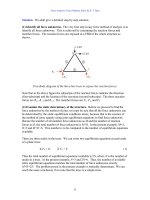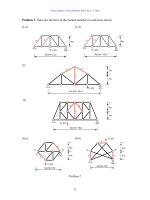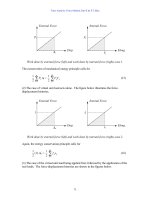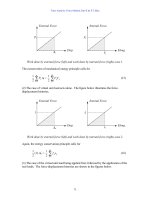Fundamentals of Structural Analysis Episode 1 Part 3 pps
Bạn đang xem bản rút gọn của tài liệu. Xem và tải ngay bản đầy đủ của tài liệu tại đây (242.65 KB, 20 trang )
Truss Analysis: Force Method, Part I by S. T. Mau
35
Solution. We shall give a detailed step-by-step solution.
(1) Identify all force unknowns. The very first step in any force method of analysis is to
identify all force unknowns. This is achieved by examining the reaction forces and
member forces. The reaction forces are exposed in a FBD of the whole structure as
shown.
Free-Body diagram of the three-bar-truss to expose the reaction forces.
Note that in the above figure the subscripts of the reaction forces indicate the direction
(first subscript) and the location of the reactions (second subscript). The three reaction
forces are R
x1
, R
y1
and R
y3
. The member forces are F
1
, F
2
, and F
3
.
(2) Examine the static determinacy of the structure. Before we proceed to find the
force unknowns by the method of joint, we must be sure that all the force unknowns can
be determined by the static equilibrium conditions alone, because that is the essence of
the method of joint, namely using joint equilibrium equations to find force unknowns.
Denote the number of all member force unknowns as M and the number of reaction
forces as R, the total number of force unknowns is M+R. In the present example, M=3,
R=3 and M+R =6. This number is to be compared to the number of equilibrium equations
available.
There are three nodes in the truss. We can write two equilibrium equations at each node
of a plane truss:
Σ F
x
= 0, Σ F
y
= 0 (1)
Thus the total number of equilibrium equations available is 2N, where N is the number of
nodes in a truss. In the present example, N=3 and 2N=6. Thus, the number of available
static equilibrium equations matches the total number of force unknowns exactly,
M+R=2N. The problem posed in the present example is statically determinate. We can
reach the same conclusion if we note that the truss is a simple truss.
1
2
3
2
3
1
1.0 kN
0.5 kN
R
x1
R
y1
R
y3
Truss Analysis: Force Method, Part I by S. T. Mau
36
(3) Solve for force unknowns. The most obvious next step is to write up the six nodal
equilibrium equations and solve for the six unknown forces simultaneously. That would
require the use of a computer. For the present example, and many other cases, an
experienced structure engineer can solve a problem by hand calculation faster than using
a computer. This hand-calculation process gives insight to the force flow from externally
applied load, through members, and to the supports. This is the process that is presented
herein.
(a) Find all reactions. Although not necessary, finding all reaction forces from
the FBD of the whole structure first is often the fastest way of solving a plane truss
problem.
Free-Body-Diagram for finding reactions.
The three reaction forces can be solved one at a time by applying the three equilibrium
equations one by one:
Σ F
x
= 0 R
x1
+ 0.5 = 0 R
x1
= −0.5 kN
Σ M
1
= 0 R
y3
(6) –(1.0)(3) –(0.5)(4) = 0 R
y3
= 0.83 kN
Σ F
y
= 0 R
y1
+ 0.83 – 1.0= 0 R
y1
= 0.17 kN
(b) Find member forces. The member forces are solved by applying nodal
equilibrium equations joint by joint. The selection of the sequence by which each joint is
utilized is based on a simple rule: No joint should contain more than two unknowns, with
one unknown in each equation preferred. Based on this rule, we take the following
sequence and use the FBD of each joint to write the equilibrium equations:
1
2
3
2
3
1
1.0 kN
0.5 kN
R
x1
R
y1
R
y3
3m
3m
4m
Truss Analysis: Force Method, Part I by S. T. Mau
37
Joint 3.
Σ F
y
= 0, F
2
(4/5)+0.83=0, F
2
= –1.04 kN
Σ F
x
= 0, –F
2
(3/5) – F
3
=0, F
3
= 0.62 kN
Joint 1.
Σ F
y
= 0, F
1
(4/5)+0.17=0, F
1
= –0.21 kN
Note that only one equation from the FBD of joint 1 is needed to find the remaining
unknown of F
1
. The second equilibrium equation is identically satisfied. The two
equilibrium equations from the FBD of joint 2 would also be identically satisfied. These
three “unused” equations can serve as a “check” for the accuracy of the computation. We
need not use these three joint equations because we have already used three equations
from the equilibrium of the whole structure at the beginning of the solution process. This
fact also points to an important point: There are no more than six independent
equilibrium equations. Any additional equations are not “independent” from the six
equations we just used because they can be derived from the linear combination of the six
equations. Any six “independent” equations are equally valid. The selection of which six
equations to use is a matter of preference and we always select those equations that give
us the easiest way of getting the answer to the unknown forces as we just did.
Example 2. Find all reaction and member forces for the loaded truss shown.
Another truss example problem for the method of joint.
Solution. A slightly different solution strategy is followed in this example.
F
2
3
F
3
0.83 kN
1
0.5 kN
0.17 kN
F
1
0.62 kN
x
y
1
2
3m
2m
3
2m
1
2
3
6 kN
1.5 m
4
5
6
3
4
5
3
4
5
4
5
Truss Analysis: Force Method, Part I by S. T. Mau
38
(1) Identify all force unknowns. The FBD of the whole structure shows there are four
reactions. Adding the six member forces, we have M=6, R=4 and M+R=10, a total of
ten force unknowns.
FBD of the whole truss.
(2) Examine the static determinacy of the structure. There are five nodes, N=5. Thus
M+R=2N=10. This is a statically determinate problem.
(3) Solve for force unknowns. This is a problem for which there is no advantage in
solving for the reactions first. The FBD of the whole structure will give us three
equations of equilibrium while we have four reaction unknowns. Thus, we cannot solve
for the four reactions with the equations from the FBD of the whole structure alone. On
the other hand, if we go from joint to joint in the following order, 3, 2, 4, 1, and 5, we
will be able to solve for member forces one node at a time and eventually getting to the
reactions.
Joint 3.
Σ F
y
= 0, F
5
(3/5)+ F
6
(3/5)= –6,
Σ F
x
= 0, –F
5
(4/5) + F
6
(4/5) =0
F
5
= – 5 kN, F
6
= – 5 kN
In this case, solving the two equations simultaneously is inevitable.
Joint 2.
Σ F
x
= 0, F
5
(4/5) + F
4
(4/5) =0, F
4
= 5 kN.
Σ F
y
= 0, F
5
(3/5) – F
4
(3/5) –F
1
= 0,
F
1
= –6 kN.
2
1
2
3
6 kN
4
5
6
R
y1
R
x1
1
3
4
5
R
x5
R
y5
F
5
3
4
5
6 kN
3
F
6
3
4
5
2
F
5
F
4
F
1
3
5
4
3
4
5
Truss Analysis: Force Method, Part I by S. T. Mau
39
Joint 4.
Σ F
x
= 0, F
6
(4/5) + F
3
(4/5) =0, F
3
= 5 kN.
Σ F
y
= 0, F
6
(3/5) – F
3
(3/5) –F
2
= 0,
F
2
= –6 kN.
Joint 1.
Σ F
x
= 0, R
x1
+ F
3
(4/5) =0, R
x1
= –4 kN.
Σ F
y
= 0, R
y1
+F
3
(3/5) +F
1
= 0,
R
y1
= 3 kN.
Joint 5.
Σ F
x
= 0, R
x5
– F
4
(4/5) =0, R
x5
= 4 kN.
Σ F
y
= 0, R
y5
+F
4
(3/5) +F
2
= 0,
R
y5
= 3 kN.
Note in both example problems, we always assume the member forces to be in tension.
This results in FBDs that have member forces pointing away from the joints. This is
simply an easy way to assign force directions. It is highly recommended because it
avoids unnecessary confusion that often leads to mistakes.
Example 3. Find the member forces in bars 4, 5, 6, and 7 of the loaded Fink truss shown.
Fink truss to be solved by the method of joint.
4
F
6
F
3
F
2
3
5
4
3
4
5
1
F
3
F
1
R
y1
R
x1
3
4
5
F
4
F
2
R
y5
5
R
x5
3
5
4
10 kN
3@2m=6m
1
3
2
4
5
6
7
1
2 3
5
6
7
8
10
11
2m
9
4
Truss Analysis: Force Method, Part I by S. T. Mau
40
Solution. We shall illustrate a special feature of the method of joint.
(1) Identify all force unknowns. The FBD of the whole structure would have shown
that there are three reactions. Adding the eleven member forces, we have M=11, R=3 and
M+R=14, a total of 14 force unknowns.
(2) Examine the static determinacy of the structure. There are seven nodes, N=7.
Thus M+R=2N=14. This is a statically determinate problem.
(3) Solve for force unknowns. Normally Fink trusses are used to take roof loading on
the upper chord nodes. We deliberately apply a single load at a lower chord node in
order to make a point about a special feature of the method of joint. We start by
concentrating on Joint 5.
Joint 5.
Σ F
y
= 0, F
4
= 0
Σ F
x
= 0, –F
8
+ F
9
=0
F
8
= F
9
In this case, it is advantageous to line up the coordinate system with the local geometry at
the node. F
4
is found to be zero because it is the only force in that direction. The pair of
forces in the x-direction must be equal and opposite because they are co-linear.
Joint 2.
F
4
= 0, F
5
= 0.
F
1
= F
2
Joint 7.
F
7
= 0, F
10
= F
11
5
x
y
F
4
F
8
F
9
2
F
5
F
4
F
2
F
1
7
F
10
F
11
F
7
Truss Analysis: Force Method, Part I by S. T. Mau
41
Joint 3.
F
7
= 0, from equilibrium of Joint 7.
Σ F
y
= 0, F
6
(2/2.23) = 10 F
6
= 11.15 kN.
That completes the solution for F
4
,F
5
,F
6
and F
7
.
Thus, with the exception of member 6, all the web members are zero-force members for
this particular loading case. For purpose of analysis under the given load the Fink truss is
equivalent to the truss shown below.
Equivalent truss to the Fink truss for the given load.
This brings up the interesting feature of the method of joint: we can identify zero-force
members easily. This feature is further illustrated in the next example.
Example 4. Identify zero-force members and equal-force members in the loaded trusses
shown.
An example of zero-force members and equal force members.
Solution. The equilibrium of forces at joint C leads to F
CG
=0 and F
BC
=F
CD
. Once we
know F
CG
= 0, it follows F
BG
=0 and then F
BF
= 0, based on the equilibrium of forces at
node G and node B, respectively. The equilibrium of forces at joint F leads to F
AF
=P and
F
EF
=F
FG
.
3
10 kN
F
3
F
2
F
6
F
7
1
2
2.23
P
A
B
C
D
E
F
G
P
F
CG
F
CD
F
BC
F
P
C
F
FG
F
EF
F
AF
10 kN
4 m
2m
2 m
Truss Analysis: Force Method, Part I by S. T. Mau
42
We can identify:
(1) zero force members. At each joint, all the forces are concurrent forces. If all the
forces are co-linear except one then the lone exception must be zero.
(2) equal force members. If two forces at a joint are co-linear and all other forces at the
joint are also co-linear in another direction, then the two forces must be equal.
An equivalent truss.
For practical purposes, the original truss problem is equivalent to the truss problem
shown above for the given loading case.
P
A
D
E
F
P
Truss Analysis: Force Method, Part I by S. T. Mau
43
Problem 1. Use the method of joint to find all reaction and member forces in the trusses
shown.
(1-a)(1-b)(1-c)
(2-a)(2-b)(2-c)
(3-a)(3-b)(3-c)
(4-a)(4-b)(4-c)
Problem 1.
3m
4m
3 kN
3m
4m
3m
8 kN
3m
4m
3m
8 kN
3 kN
3m
4m
4 kN
3m
4m
4 kN
3m
2m
6 kN
2m
1.5m
1.2 m
1.6 m
0.9 m
2 m2 m
1.2 m
0.9 m
0.7 m
5 kN
4 kN
0.9 m
0.9 m
0.7 m
4kN
0.9 m
5kN
1.2 m
1m
1m
1 kN
2 m2 m
1m
1m
2 kN
2 m2 m
1m
1m
2 kN
1 kN
Truss Analysis: Force Method, Part I by S. T. Mau
44
Example 5. Find member forces in bars in the 3
rd
panel from the left of the truss shown.
An example problem for the method of section.
Solution. We shall solve this problem by the method of section with the following
procedures.
(1) Name all joints. We can refer to each joint by a symbol and each member by the two
end joints as shown in the figure below. We also define an x-y coordinate system as
shown. We need to find F
IJ
, F
CJ
, and F
CD
. The truss is stable and determinate.
(2) Find reactions. We have to look at the FBD of the whole truss.
The FBD to find the reactions.
ΣM
A
=0, (12) (30) – (18) R
GV
= 0, R
GV
= 20 kN.
ΣF
x
=0, R
AH
= 0.
ΣM
G
=0, (18) R
AV
– (6)(30) = o, R
AV
= 10 kN.
(3) Establish FBD. We make a vertical cut through the 3
rd
panel from the left, thus
exposing the member force of members IJ, CJ and CD. We can take the left or the right
portion as the FBD. We choose the left portion because it has less number of external
4 m
6@3 m = 18 m
30 kN
4 m
6@3 m = 18 m
30 kN
A
B
C
D
E
F
G
H
I
J
K
L
R
AV
R
GV
R
AH
x
y
Truss Analysis: Force Method, Part I by S. T. Mau
45
forces to deal with. We always assume the member forces are tensile. We have already
obtained R
AV
= 10 kN.
FBD exposing a section through the third panel from left.
ΣM
C
=0, (4) F
IJ
+ (6) R
AV
= 0, F
IJ
= – 1.5 R
AV
= –l15 kN.
ΣM
J
=0, – (4) F
CD
+ (9) R
AV
= 0, F
CD
= 2.25 R
AV
= 22.5 kN.
ΣF
y
=0, (0.8) F
CJ
+ R
AV
= 0, F
CJ
= –1.25 R
AV
= –12.5 kN.
Note that we choose the moment center at C and J, respectively, because in each case the
resulting equation has only one unknown and therefore can be solved easily.
To illustrate the effect of taking a different FBD, let us choose the right part of the cut as
the FBD. Note that we already know R
GV
= 20 kN.
Alternative FBD exposing the member forces of the 3
rd
panel.
By taking the right portion as the FBD we include the applied 30 kN force in the FBD
and it will show up in all equilibrium equations.
ΣM
C
=0, – (4) F
IJ
+ (6) (30) – (12) R
GV
= 0, F
IJ
= – 3 R
GV
+ 45 = –15 kN.
ΣM
J
=0, (4) F
CD
+ (3) (30) – (9) R
GV
= 0, F
CD
= 2.25 R
GV
– 22.5= 22.5 kN.
A
B
C
H
I
J
R
AV
x
y
F
CJ
F
CD
4 m
3@ 3m=9 m
4@ 3m=12 m
x
y
4 m
30 kN
C
D
E
F
G
J
K
L
R
GV
F
I
J
F
C
J
F
CD
Truss Analysis: Force Method, Part I by S. T. Mau
46
ΣF
y
=0, – (0.8) F
CJ
– 30 + R
GV
= 0, F
CJ
= –37.5 +1.25 R
GV
= –12.5 kN.
Example 6. Find member forces in bars in the 2
nd
panel from the left of the truss shown.
Another example problem for the method of section.
Solution. The inclined chord geometry will cause complications in computation, but the
process is the same as that of the last example.
(1) Find reactions. This is a simple truss, stable and determinate.
FBD for reaction forces.
ΣM
A
=0 – (16) R
EV
+(4)3+(8)6+(12)9=0, R
EV
=10.5 kN.
ΣM
E
=0 (16) R
AV
– (12)3-8(6)-(4)9=0, R
AV
=7.5 kN.
ΣF
x
=0 R
AH
=0 kN.
(2) Establish FBD. We make a cut through the second panel from the left and choose
the left portion as the FBD.
A
3 kN
6 kN
9 kN
B
C
D
E
F
G
H
4 @ 4m=16 m
2m
3m
A
3 kN 6 kN 9 kN
B
C
D
E
F
G
H
4 @ 4m=16 m
2m
3m
R
EV
R
AV
R
AH
x
y
Truss Analysis: Force Method, Part I by S. T. Mau
47
FBD for the 2nd panel member forces.
In order to find F
BC
we want to find a moment center that is the intersection of the two
other unknowns. The intersection point of F
FG
and F
FC
is point F.
ΣM
F
=0 – (3) F
BC
+(4)7.5=0, F
BC
=10.00 kN.
Similarly, we take moment about point C so that the only unknown force in the ensuing
equilibrium equation would be F
FG
. In writing the moment equilibrium equation, we
utilize the fact that F
FG
can be transmitted to point K and the horizontal component of
F
FG
at K has no contribution to the equilibrium equation while the vertical component is
(2/4.47) F
FG
=0.447 F
FG
has, as shown in the left figure below
.
ΣM
C
=0 (10) 0.447F
FG
+(8)7.5– (4)3=0, F
FG
= –10.74 kN.
Two FBDs to find F
FG
.
Alternatively we can transmit F
FG
to point G, and use the horizontal component
(4/4.47) F
FG
=0.894 F
FG
in the moment equation, as shown in the right figure above.
ΣM
C
=0 (5) 0.894F
FG
+ (8)7.5– (4)3=0, F
FG
= –10.72 kN.
A
3 kN
B
F
7.5 kN
F
FG
F
FC
F
BC
3m
C
4m 4m
A
3 kN
B
F
7.5 kN
K
F
FG
F
FC
F
BC
3m
0.447F
FG
2m
C
4m 4m
F
FG
4
2
4.47
A
3 kN
B
F
7.5 kN
F
FG
F
FC
F
BC
3m
G
4m 4m
2m
F
FG
0.894F
FG
C
Truss Analysis: Force Method, Part I by S. T. Mau
48
To find F
FC
we need to go out of the region of the truss to find the moment center (K) as
the shown in the left figure above, and use the vertical component of the transmitted F
FC
at point C.
ΣM
K
=0 (10) 0.6F
FC
– (2)7.5+(6)3=0, F
FC
= -0.50 kN.
Note that all these additional efforts are caused by the inclined upper chord of the truss.
Example 7. Find the force in the top and bottom chord members of the third panel from
the left of the K-truss shown.
K-truss example.
Solution. The K-truss is a simple truss that requires a special cut for the solution of top
and bottom chord member forces as we shall see shortly. It is stable and determinate.
(1) Find reactions. Since the truss and the loading are symmetric, the reactions at both
supports are easily found to be 8 kN upward and there is no horizontal reaction at the left
support.
(2) Establish FBD. The special cut is shown by the dotted line below.
A cut to establish FBD for the top and bottom cord member forces.
6@3m=18m
4m
4m
16 kN
16 kN
Truss Analysis: Force Method, Part I by S. T. Mau
49
This particular cut separates the truss into two parts. We shall use the left part as the
FBD.
FBD for top and bottom chord member forces.
Although there are four forces at the cut, two of them are on the same line. When
moment center is selected at either node E or node G, these two forces will not appear in
the equilibrium equation, leaving only one unknown in each equation.
ΣM
E
=0, (6) 8 – (8) F
GJ
=0 F
GJ
= 6 kN.
ΣM
G
=0, (6) 8 + (8) F
EH
=0 F
EH
= −6 kN.
Alternatively, we may choose the right part as the FBD. The same results will follow but
the computation is slightly more involved.
Alternative FBD for top and bottom chord member forces.
ΣM
E
=0, (12) 8 – (3) 16 – (8) F
GJ
=0 F
GJ
= 6 kN.
ΣM
G
=0, (12) 8 – (3) 16 + (8) F
EH
=0 F
EH
= −6 kN.
B
D
8 kN
C
A
F
EH
E
H
G
F
GJ
J
8m
6m
16 kN
8 kN
J
H
E
G
F
EH
F
GJ
8m
3m 9m
Truss Analysis: Force Method, Part I by S. T. Mau
50
Example 8. Find the force in the inclined web members of the third panel from the left
of the K-truss shown.
K-Truss example – inclined web members.
Solution. A different cut is needed to expose the web member forces.
(1) Establish FBD. To expose the force in the inclined web members, we may make a
cut through the third panel.
A cut to expose web member forces.
This cut exposes four forces, the top and bottom member forces which are known and the
two inclined web member forces, F
FH
and F
FJ
, which are unknown.
FBD for the inclined web members of the third panel.
6@3m=18m
4m
4m
16 kN
16 kN
F
J
H
F
J
H
F
FH
F
FJ
8 kN
4m
4m
3m
Truss Analysis: Force Method, Part I by S. T. Mau
51
In this case, the application of two force equilibrium equations produces the desired
results. In writing the equation for the horizontal forces, we note that the top and bottom
chord member forces cancel each other and will not appear in the equation. In fact this is
a special feature, which is useful for the analysis of web member forces.
Σ F
x
= 0 (0.6)F
FH
+ (0.6) F
FJ
= 0
Σ F
y
= 0 (0.8)F
FH
− (0.8) F
FJ
= 8
Solving the simultaneous equations, we obtain
F
FH
= 5 kN and F
FJ
= −5 kN
We observe that not only the top and bottom chord members have the same magnitude
forces with opposite signs, the inclined web members are in the same situation.
Furthermore, in the present example, the inclined web member forces are the same in the
second and third panel, i.e.
F
CE
= F
FH
= 5 kN F
CG
= F
FJ
= −5 kN
This is because the FBD for these member forces yields equations identical to those for
the third panel.
FBD for the inclined web members of the second panel.
Σ F
x
= 0 (0.6)F
CE
+ (0.6) F
CG
= 0
Σ F
y
= 0 (0.8)F
CE
− (0.8) F
CG
= 8
Example 9. Discuss methods to find the force in the vertical web members of the K-truss
shown.
F
G
E
F
CE
F
CG
8 kN
4m
4m
3m
C
Truss Analysis: Force Method, Part I by S. T. Mau
52
K-Truss analysis – vertical web members.
Solution. We can use either the method of section or the method of joint, but the pre-
requisite is the same: need to know the force in either the lower inclined web member or
the upper inclined web member.
(1) Method of section.
Cuts to expose vertical web members
Cut A exposes an upper vertical web member, a, and a lower inclined web member, a’,
whose forces have a vertical component. Once F
a’
is known, F
a
can be computed from
the equilibrium equation for forces in the vertical direction of the FBD to the left of the
cut.
Cut B exposes the forces of a lower vertical web member, b, and an upper inclined web
member, b’; each force has a vertical component. Once F
b’
is known, F
b
can be
computed from the equilibrium equation for forces in the vertical direction of the FBD to
the right of the cut.
Cut C exposes the forces of the central vertical web member and two inclined web
members; each force has a vertical component. Once the forces in the two inclined web
members are known, the force in the central vertical member can be computed from the
equilibrium equation for forces in the vertical direction of the FBD to the left or right of
the cut.
6@3m=18m
4m
4m
16 kN
16 kN
A
B
C
a
a'
b'
b
Truss Analysis: Force Method, Part I by S. T. Mau
53
(2) Method of joint.
Joints used to solve for vertical web member forces.
At each of the circled joints, the vertical web member forces can be computed if the force
of the inclined web member is known. For the central vertical web member, we need to
know the forces of the two joining inclined web members. In the present case, since the
load is symmetrical, the two inclined web members have identical forces. As a result, the
force in the central vertical web member is zero.
Example 10. Find the force in member a of the compound truss shown.
A compound truss example.
Solution. The method of section is often suitable for compound truss analyses.
(1) Identify truss. This is a stable and determinate truss. It is a compound truss with
three links, a, b and c, linking two simple trusses. Each node has at least three joining
members. Thus, the method of joint is not a good option. We need to use the method of
section.
(2) Find reactions. Since the geometry is simple enough, we can see that the horizontal
reaction at support A is zero and the vertical reactions at support A and B are 10 kN and 5
kN, respectively.
(3) Establish FBD. By cutting through the three links, we obtain two FBDs. We choose
the upper-left one because it does not involve the applied force.
3@3m=9m
4m
4m
15 kN
a
A
B
b
c
16 kN
Truss Analysis: Force Method, Part I by S. T. Mau
54
FBD for the central link.
To find F
a
we note that the other two unknown forces, F
b
and F
c
, are parallel to each
other, making it impossible to take moment about their intersection. On the other hand, it
becomes useful to examine the force equilibrium in the direction perpendicular to the two
parallel forces. This direction is denoted in the above figure as the x-direction. We can
decompose the 10 kN reaction at support A and the unknown force F
a
into components in
the x-direction and write the equilibrium equation accordingly.
Σ F
x
= 0, (0.6)10 + (0.6) F
a
= 0 F
a
= −10 kN.
3@3m=9m
4m
4m
AB
10 kN
F
a
F
c
F
b
5
3
4
5
4
3
x

